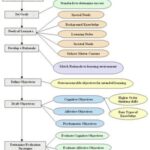Rationale: Students can improve their writing by practicing using the six traits. There are a variety of ways to organize writing as well as other things in everyday life.
Students Goals and Objectives:
• Use a variety of modes of communication to promote learning (8.2) Students will be reading, writing and speaking about the subject to build on their understanding of the six traits of writing.
• Create learning groups in which students learn to work collaboratively and independently (6.6) Students will be expected to work both by themselves and with their classmates for the lesson.
• Use their understanding of students to create connections between the subject matter and student experiences (4.2). Students will relate their own experiences of in the classroom to the lesson. They will practice using parts of the six traits of writing, especially organization.
Teacher Goals and Objectives:
• Use a broad knowledge base to create interdisciplinary learning experiences (1.2) Students will be using the areas of language arts and math to develop their understanding of the six traits of writing.
• Model a commitment to lifelong learning students (1.3) Students will develop an understanding of why these traits are so important to their everyday writing.
• Select instructional materials and resources based on their comprehensiveness, accuracy, ideas and concepts (2.3). The materials used to teach this lesson will be developmentally appropriate and will explain clearly the subject being taught.
• Design instruction that meets the current cognitive, social and personal needs of their students (3.2). The instruction used will be appropriate for the needs of the students and will help in their comprehension of the topic.
• Design instruction that accommodates individual differences (4.1). The project is well developed for all students, regardless of time needed or ability.
• Make appropriate accommodations for students who have learning differences (4.4) The project is well developed for all students, regardless of time needed or ability. They can learn in a variety of ways, including orally, kinestically, and visually.
• Use tasks that engage students in exploration, discovery and hands-on activities (5.5). The model lesson will keep the students actively engaged by using hands-on activities.
• Communicate clear expectations for achievement that allow students to take responsibility for their own learning (6.7). Students will know what they are being assessed on for successful achievement.
• Emphasize oral and written communication though the instructional use of discussion, listening and responding to the ideas of others and group interaction (8.4). Students will be using a variety of modes of communication during the duration of the lesson.
Instructional Materials and Resources:
• The True Story Of The Three Little Pigs by Jon Scieszka
Learner Factors: This lesson incorporates Gardner’s Eight Intelligences. The subject matter will be discussed orally for those who leave from interpersonal and social methods. The story development will be hands on for those who do best with bodily and kinesthetic learning. The story also will be provided for those children that feel they better express themselves on paper, as well as the use of discussion for those who are verbal and linguistic learners.
This lesson will also do well for different levels of learners. Adequate time and attention will be given with the project and discussion. Help will be offered, at any time, to any students requiring it. Students will get the opportunity to work together and independently to maximize the opportunity to learn.
Environmental Factors: No significant changes will be used for this lesson.
Instructional Sequence:
Motivation: In order to complete this lesson, the teacher and students will discuss the six traits of writing. We will discuss how these six traits help the students become better writers. Students will be allowed to express their own thoughts and ideas on these ideas. The teacher will read aloud to the students, “The True Story Of The Three Little Pigs”. The story is a different version of the well known story of The Three Little Pigs, which will keep the students interested.
The students will learn about the various ways one can organize a piece of writing, in this case a story. The author of the story, Jon Scieszka, changed the events of the story slightly to write his book.
Teacher Modeling: The teacher will explain the purpose of this activity before it begins, so that the students have an understanding of how this lesson will be useful to them. The teacher will give each student a writing utensil and blank paper. Then the teacher will read the instructions aloud and provide a copy to each student so that they can follow along.
The students will pick their own story and write a new version. They can add some events and change others, but its organization must be clear. The story must have a beginning, middle, and end. A piece must be written so that a reader is always interested.
Closure: When the activity is complete, students will be able to express their opinion on the lesson. A review to the six traits of writing will be given. Using oral and written means, students will be asked to evaluate the lesson. They will show the group their personal story and tell how they developed it. They will also be asked to tell the group how they organized it and why they chose the way they did.
Assessment Activities:
Students will be actively engaged in-group discussion before and after the lesson. The teacher will examine their understanding both using oral and written means. Their participation in the lesson and within the group will also be recognized.

